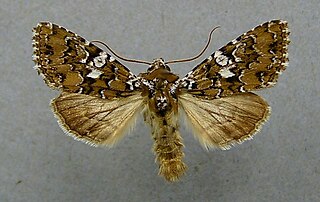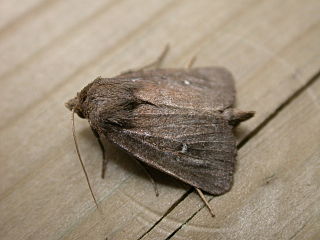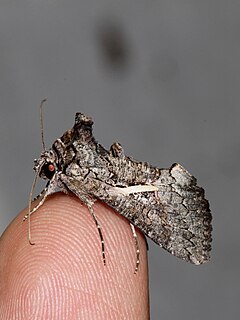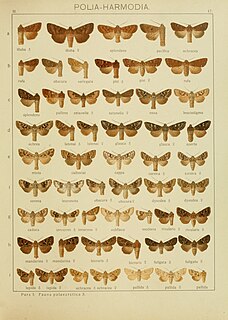
The lychnis is a moth of the family Noctuidae. It is found in northern and western Europe and Turkey. It has an Atlantic-Mediterranean distribution. In the East Palearctic it is replaced by Hadena capsincola.

Conistra rubiginosa, the black-spot chestnut, is a moth of the family Noctuidae. The species was first described by Giovanni Antonio Scopoli in his 1763 Entomologia Carniolica. It is found in Europe.

Hadena albimacula, the white spot, is a species of moth of the family Noctuidae. It is found in Europe.

Archanara geminipuncta, the twin-spotted wainscot, is a moth of the family Noctuidae which is found in Europe, Lebanon, Israel, Turkey, Iraq and the Caucasus. The species was first described by Adrian Hardy Haworth in 1809.

Ctenoplusia accentifera is a moth of the family Noctuidae. It is found in South-Western Europe, Greece, Africa, the Near East and Asia Minor.

Grammodes stolida, the geometrician, is a moth of the family Erebidae. The species was first described by Johan Christian Fabricius in 1775. It is found in Africa, southern Europe, most of Asia and Australia. It migrates to central and northern Europe as far north as England, Denmark and Finland.
Hadena clara is a species of moth of the family Noctuidae. It is found in Morocco, southern Europe, Turkey, Armenia, Azerbaijan, the Caucasus region, Israel, Lebanon, Syria and Iran.

Hadena perplexa, the tawny shears or pod lover, is a species of moth of the family Noctuidae. It is found in Morocco, Algeria, Tunisia, Europe, Turkey, Israel, Lebanon, Syria, Jordan, Iran, Iraq, northern Asia, Central Asia, northern India and western China.

Hadena silenes is a species of moth of the family Noctuidae. It is found in Europe, Turkey, Israel, Iran and Turkmenistan.
Hadena sancta is a species of moth of the family Noctuidae. It is found in Spain, Corsica, Sardinia, Malta, North Africa, Israel, Lebanon, Syria, Jordan, Cyprus, Turkey, Saudi Arabia and Yemen.

Agrochola litura, the brown-spot pinion, is a moth of the family Noctuidae. The species was first described by Carl Linnaeus in 1761. It is found in Europe and the Middle East. It is possibly also present in North Africa, but this is unclear because similar looking species Agrochola meridionalis is found there.

Hadula melanopa, the broad-bordered white underwing, is a moth of the family Noctuidae. The species was first described by Carl Peter Thunberg in 1791. Subspecies H. m. melanopa is found in northern Scandinavia; subspecies H. m. rupestralis is found in the Alps, the Balkan Mountains and the Apennine Mountains; subspecies H. m. brunnea is found in mountainous areas of Great Britain and subspecies H. m. koizumidakeana is found in Japan.

Lasionycta calberlai is a moth of the family Noctuidae. It is found in France , Switzerland, Italy and Slovenia.

Hadena caesia, also called the grey, is a species of moth of the family Noctuidae. It has a scattered distribution all over Europe.

Hadena filograna is a species of moth of the family Noctuidae. Subspecies filograna is found from central and southern Europe to Anatolia. The most northern part of the range is Sweden. Subspecies conspargata is found in Ukraine and from southern Russia to the Altai mountains and ssp. rungsi is found in North Africa.

Barrett's marbled coronet is a species of moth of the family Noctuidae. It is found from France through south-eastern Europe to Central Asia. In the north it is found up to the Baltic region. It is also present in North Africa.

Chloantha hyperici, the pale-shouldered cloud, is a moth of the family Noctuidae. It is found in southern Central Europe and from southern Europe to the Near East and Anatolia, Israel, Iraq, the Persian Gulf and the Caucasus, as well as northern Denmark, southern Sweden, southern Norway and south-western Finland.

Cucullia xeranthemi is a species of moth of the family Noctuidae. In southern Europe, it is found locally from northern Spain, Italy and southern France to the Balkans. In the east, it is found from Lower Austria and Hungary to southern Russia and western Siberia.

Lithophane furcifera, the conformist, is a moth of the family Noctuidae. The species was first described by Johann Siegfried Hufnagel in 1766. It is found from central Europe, east to the Black Sea region, the Caucasus and western Siberia. In the mountains, it is found up to elevations of 1,800 meters.

Callopistria latreillei, Latreille's Latin, is a moth of the family Noctuidae. The species can be found in the Palearctic realm, most parts of Europe, Asia, and in Africa from Egypt to South Africa. The habitat consists of rocky limestone slopes with deciduous woodland.


















